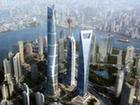| Videos | • Latest |
|
• Feature | • Sports | • Your Videos |
China's skyscraper boom

 0 Comment(s)
0 Comment(s) Print
Print E-mail CNTV, May 28, 2012
E-mail CNTV, May 28, 2012
With countless new, modern skyscrapers popping up all over the country, China is becoming the place where wild architectural dreams come true. But is China's architecture industry going in the right direction?
In this edition of "Designing the Future" series, our reporter Li Qiuyuan digs deeper to find out what the real costs behind the skyscraper building boom are.
Nothing can stop China's skyscrapers from getting higher.
As the iconic Shanghai Tower is being constructed in the city's Manhattan-like district of Pudong, Shanghai is having another "race to the sky".
Li Qiuyuan, Shanghai, said, "China's construction boom is continuing. The country now accounts for 53% of the world's skyscrapers that are under construction. These super high rise buildings are not only increasing in numbers, their height is also constantly breaking records."
 |
|
As the iconic Shanghai Tower is being constructed in the city's Manhattan-like district of Pudong, Shanghai is having another "race to the sky." |
But is height a barometer of boom?
Skyscrapers might be a symbol of prosperity and modernization for some, but for economists, the high-rise building boom carries exactly the opposite message.
Economist Andrew Lawrence's Skyscraper Index has shown that the world's tallest buildings have risen on the eve of economic downturns.
If so, will China fulfill this prophecy once again?
Gu Jianping, Director of Shanghai Tower Construction Co.,said, "Timing is everything. You have probably heard of the 'Lawrence curse'. It says skyscrapers could destabilize the economy. But when we chose to start the Shanghai Tower project, it was in 2008 when the global economic crisis struck. We started on the rock bottom of the business cycle. It takes times for the economy to recover. And, because building the Shanghai Tower will take 6 years, there's reason to believe when the project is completed, the economy will get better. And what's more, the timing has helped us reduce construction costs dramatically."
While the director keeps an optimistic outlook, the land-saving skyscrapers have also long been criticized for harming the environment, especially the building process.
Li Qiuyuan, Shanghai, said, "Behind me is the construction site of the Shanghai Tower. Upon its completion in 2014, it'll be the tallest building in China, and the 2nd tallest in the world."
The ambitious project embraces some green technology, aiming to bring a sustainable spirit to the country's construction industry.
The tower's unique spiral form design and its "intelligent skin" will help the site overcome a number of major challenges.
Gao Zhenfeng, Chief Engineer of Shanghai Center Building Project, said, "We want to reduce the impact on surrounding areas as much as possible. The spiral form reduces wind loads and captures rainwater, which is then used in the building's air conditioning and central heating. The building's facade is completely transparent and bio-climatic. It consists of a double skin glass form, with the space between the internal and external walls creating additional insulation and solar gain control."
While the construction sector gets greener, China's skyscrapers are also more multi-functional than American ones.
Instead of creating a single office building, Chinese high-rises like this Jinmao Tower have shopping malls on the lower floors, office rooms in the middle section and luxury hotel rooms at the top.
It's not just the building of such a complex that is expensive, the maintainance is also money-consuming.
But the designer of the tower says developers and city planners are not worried about getting money back.
Zhang Jiezheng, Chief Architect of Shang Hai Inst. Architectural Design, said, "They believe the high land prices will generate high returns, because the height is a major attraction. The demand for space in Shanghai is big, and foreign companies are especially eager to move into such skyscrapers as the Chinese economy keeps expanding. You see, people have a natural tendency to want to be higher for better sights."
And while the debate on the pros and cons of skyscrapers continues to carry on, we can only hope the good wishes for these high-rises do not turn into a manic obsession that will exhaust economic growth.






Go to Forum >>0 Comment(s)